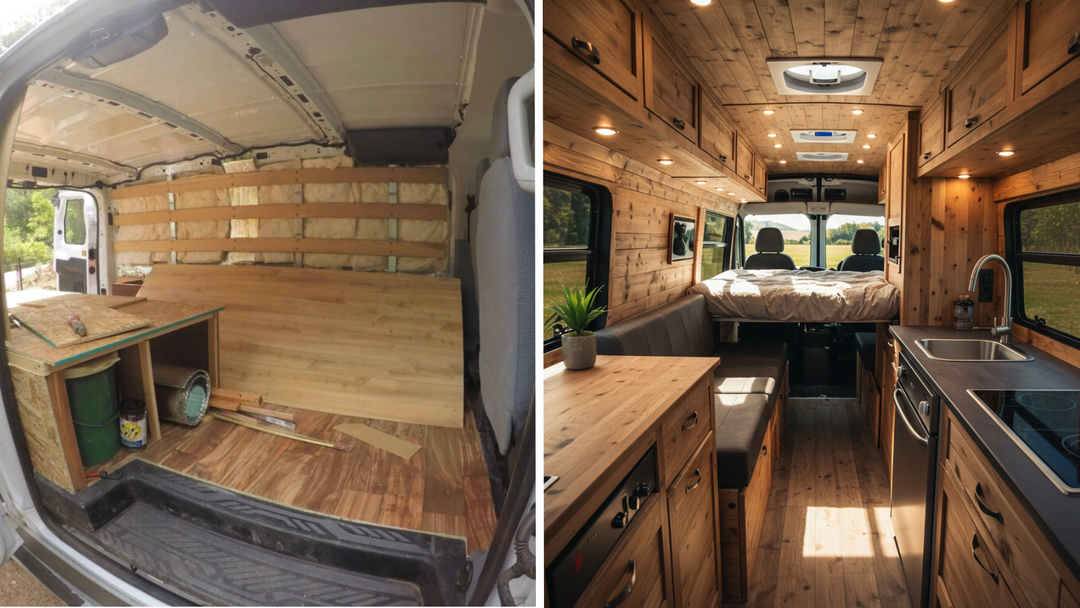Sideways Sleeping in a Van: Pros, Cons, and How to Do It Right
Why Sleeping Sideways Might Be the Smartest Move You Make
If you’re new to van building, it’s easy to assume the bed needs to run front-to-back. That’s what the van gives you, right? But here’s the secret that seasoned builders already know:
Sleeping sideways can save you serious space—and make your layout feel 10x more open.
In this guide, we’re breaking down exactly what sideways sleeping is, the real-world pros and cons, and how to make it happen (without ruining your van or overcomplicating your build).
Whether you're a weekend DIYer or a full-time builder, this article will help you decide if sideways is the right call—and how to do it right if it is.
What Is Sideways Sleeping?
Sideways (or east-west) sleeping means your bed runs across the van, from one wall to the other—rather than lengthwise, front to back.

This layout only works if the space from wall to wall is wide enough to fit your full body. For many vans, that’s a tight squeeze—or impossible—unless you make some modifications.
But those modifications? They can be game-changers.
The Pros of Sideways Sleeping
✅ You Save Major Floor Space
Instead of using 6+ feet of van length for your bed, sideways sleeping can reclaim up to 12 inches or more. That space can now go toward:
-
A larger kitchen
-
A dedicated workspace
-
Bigger garage storage
-
Just… breathing room
✅ It Opens Up More Layout Possibilities
With a sideways bed, you’re not locked into a linear flow. You can place the kitchen, gear storage, fridge, and seating more creatively.
✅ It Feels More Spacious
When the bed isn’t dominating the length of the van, the interior feels roomier, brighter, and easier to move around.
✅ Faster Bed Access
You don’t have to crawl over your partner or wedge yourself into a corner. Sideways beds can be lower, simpler, and quicker to get in and out of.
The Cons of Sideways Sleeping
❌ Not All Vans Can Do It Natively
Most vans have an interior width of around 70 inches. Subtract insulation, walls, and framing, and you’re often down to 65 inches or less. That’s tight if you’re 6 feet tall.
❌ Comfort Depends on Planning
If you don’t account for insulation, framing, or bed structure, you could be stuck curling up every night.
❌ May Require Modifications
To comfortably sleep sideways, many builds need:
-
Window flares / bump-outs / capsules
-
Recessed window framing
-
Trimmed interiors
But not all solutions require cutting into the van. More on that below.
How to Sleep Sideways in a Van (The Right Way)
1. Measure the Interior Width at Bed Height
Most vans are wider near the floor and narrower higher up. Measure at the height where your bed platform will sit—typically 24"–36" from the floor.
You’ll need at least 72–74 inches of usable width for comfortable sideways sleeping. If you come up short, keep reading.
2. Know Your Options
You’ve got two main routes:
🛠 Option A: Exterior Modifications (Flares or Capsules)

Add space outside the van to give your bed more width. Great if you want to:
-
Sleep fully stretched out
-
Use a wider mattress
-
Keep insulation thick
Product Tip: If you’re going this route, check out our Sprinter Flare Trim Rings, designed to finish off your flare cutout cleanly and quickly.
🛠 Option B: Inset Solutions (Innie Pocket Sleepers)

Instead of bumping out, recess in by using the van’s existing window cavities. This gives you several extra inches without altering your van’s exterior.
Product Tip: Our Transit Innie Sleepers are molded ABS inserts designed to tuck into the window space, giving you just enough extra room for sideways sleeping—no exterior mods required.
Which Vans Work Best for Sideways Sleeping?
|
Van Model |
Sideways Fit Stock |
With Innie Sleepers |
With Flares |
|
Mercedes Sprinter |
Not quite |
✓ |
✓✓✓ |
|
Ford Transit (High Roof) |
Tight |
✓ |
✓✓ |
|
Ram Promaster |
Often fits |
N/A |
✓ (rare) |
Every build is different. If you're on the edge, mock it up with foam board or wood to test dimensions.
Pro Tip 🛠️
Most DIYers think they need flares or bump-outs to sleep sideways, but many Transit builders get the same space gain by trimming into the factory window pockets using solutions like Innie Sleepers—no exterior modifications required.
Final Thoughts
Sideways sleeping isn’t just a clever trick—it’s a legit way to unlock space and simplify your build. It’s especially powerful for builders who want to:
-
Keep the van’s profile clean
-
Maximize storage or kitchen size
-
Avoid complicated buildouts
If you plan smart, measure carefully, and use tools like Innie Sleepers or Trim Rings, sideways sleeping can be one of the best layout decisions you make.
✅ Want to go deeper? Check out our full breakdown: Sleeping Capsules for Vans
Stay smart. Sleep sideways.
– The GoCode Team





